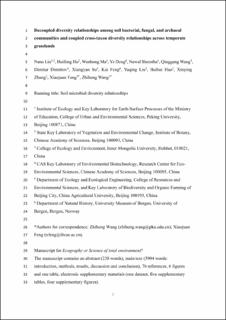| dc.description.abstract | Soil microbes assemble in highly complex and diverse microbial communities, and microbial diversity patterns and their drivers have been studied extensively. However, diversity correlations and co-occurrence patterns between bacterial, fungal, and archaeal domains and between microbial functional groups in arid regions remain poorly understood. Here we assessed the relationships between the diversity and abundance of bacteria, fungi, and archaea and explored how environmental factors influence these relationships. We sampled soil along a 1500-km-long aridity gradient in temperate grasslands of Inner Mongolia (China) and sequenced the 16S rRNA gene of bacteria and archaea and the ITS2 gene of fungi. The diversity correlations and co-occurrence patterns between bacterial, fungal, and archaeal domains and between different microbial functional groups were evaluated using α-diversity and co-occurrence networks based on microbial abundance. Our results indicate insignificant correlations among the diversity patterns of bacterial, fungal, and archaeal domains using α-diversity but mostly positive correlations among diversity patterns of microbial functional groups based on α-diversity and co-occurrence networks along the aridity gradient. These results suggest that studying microbial diversity patterns from the perspective of functional groups and co-occurrence networks can provide additional insights on patterns that cannot be accessed using only overall microbial α-diversity. Increase in aridity weakens the diversity correlations between bacteria and fungi and between bacterial and archaeal functional groups, but strengthens the positive diversity correlations between bacterial functional groups and between fungal functional groups and the negative diversity correlations between bacterial and fungal functional groups. These variations of the diversity correlations are associated with the different responses of microbes to environmental factors, especially aridity. Our findings demonstrate the complex responses of microbial community structure to environmental conditions (especially aridity) and suggest that understanding diversity correlations and co-occurrence patterns between soil microbial groups is essential for predicting changes in microbial communities under future climate change in arid regions. | en_US |
